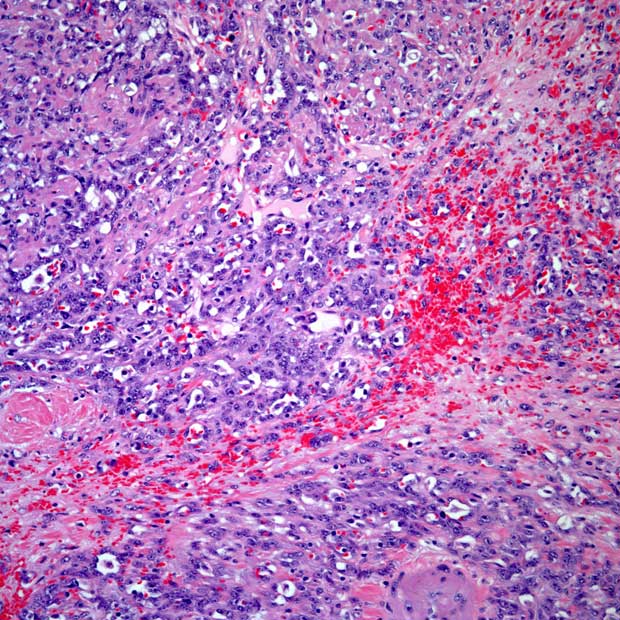UGN-102 May be an Effective Non-Surgical Option For Bladder Cancer Subtype
Among patients with low-grade, non–muscle invasive bladder cancer, intravesical UGN-102 appears to improve outcomes vs standard surgical treatment in two phase 3 trials.
UGN-102 is a sustained-release, hydrogel-based formulation designed to facilitate longer exposure of bladder tissue to mitomycin. If approved, it could allow the treatment of tumors without surgery, and it would be the first non-surgical therapeutic for this bladder cancer subgroup.

Intravesical UGN-102 (mitomycin) improved clinical outcomes among patients with low-grade, intermediate-risk, non–muscle invasive bladder cancer (NMIBC), thereby meeting the primary end points of the phase 3 ATLAS (NCT04688931) and ENVISION trials (NCT05243550), according to a press release from UroGen Pharma.
The agent reduced the risk of recurrence, progression, or death by 55% vs transurethral resection of bladder tumor (TURBT) alone in the ATLAS trial, and met its primary end point of disease-free survival (DFS). The rate of complete response (CR) at 3 months among patients treated with UGN-102 was 64.8% compared with 63.6% among patients who received a TURBT.
Moreover, in the ENVISION trial, the 3-month CR rate among patients who received UGN-102 was 79.2%. Additional data from the trial on duration of response (DOR) are planned for release in 2024, as is the submission of a new drug application (NDA) to the FDA, assuming further findings are positive.
The agent was tolerated well in both trials, and its safety profile was consistent with prior data.
“UGN-102 has demonstrated a robust and consistent therapeutic profile across multiple clinical trials, providing a compelling picture of its potential to be a transformational product and advance the standard of care away from repetitive surgery to a minimally invasive, non-surgical option for [low-grade, intermediate-risk non–MIBC],” Liz Barrett, president and chief executive officer at UroGen, said in the press release.
UGN-102 is a sustained-release, hydrogel-based formulation designed to facilitate longer exposure of bladder tissue to mitomycin. If approved, it could allow the treatment of tumors without surgery, and it would be the first non-surgical therapeutic for this bladder cancer subgroup. Patients receive treatment with the agent through a standard urinary catheter in an outpatient setting.
“While TURBT is the standard treatment for bladder cancer, the recurrent nature of low-grade, intermediate-risk non–[MIBC] means that patients will undergo multiple surgeries that come with risks for this older patient population,” Sandip Prasad, MD, MPhil, director of Genitourinary Surgical Oncology at Morristown Medical Center/Atlantic Health System, said in the press release. “Based on these compelling data, I am optimistic that UGN-102, if approved, may change the treatment paradigm for these patients who lack non-surgical options to manage the ongoing burden of this highly recurrent disease.”
The single-arm, multinational ENVISION trial includes an enrolled population of 240 patients with low-grade, intermediate-risk disease from 56 sites, and is assessing the agent as a primary chemoablative therapy. Enrolled patients received 6 intravesical doses of UGN-102 once-weekly. The primary end point is the CR rate at 3 months after the first dose. DOR, durable CR rate, and DFS are among the secondary end points.
The open-label, randomized, controlled ATLAS trial is assessing UGN-102 with or without TURBT vs TURBT alone in 282 patients from the United States, Europe, and Israel. Those in the experimental arm received 6 weekly intravesical doses of UGN-102. Any patients with persistent disease at 3 months in either arm underwent a TURBT, whereas those with a CR underwent assessment over long-term follow-up for evidence of recurrence. The primary end point is DFS. The secondary end points include time to recurrence, CR rate, and DOR.
Reference
UGN-102, in development as the potential first non-surgical therapy for LG-IR-NMIBC, met primary endpoints in both phase 3 ATLAS and ENVISION clinical trials. News Release. UroGen Pharma Ltd. July 27, 2023. Accessed July 28, 2023. https://bit.ly/3Qh7saJ
Newsletter
Stay up to date on recent advances in the multidisciplinary approach to cancer.